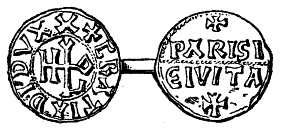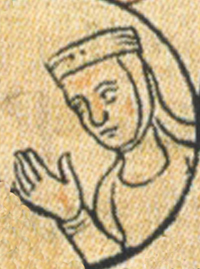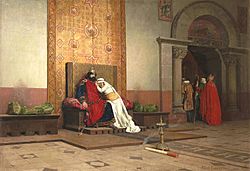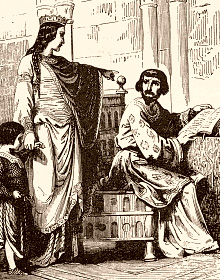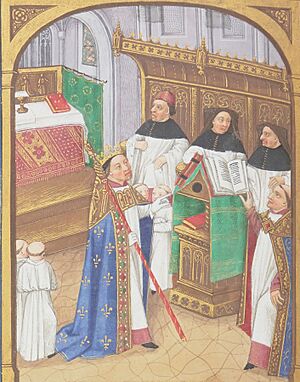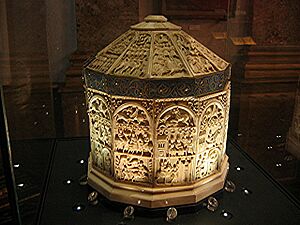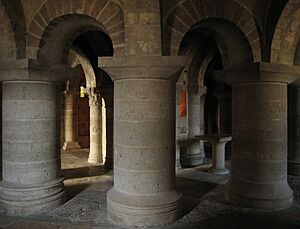Robert II of France facts for kids
Quick facts for kids Robert II |
|
|---|---|
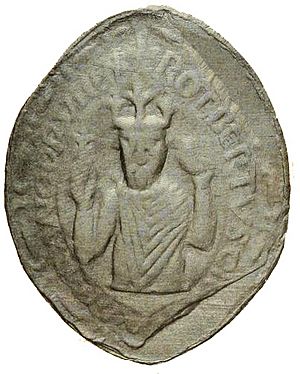
Seal of King Robert II
|
|
| King of the Franks (more...) | |
| Co-reign Solo-reign |
30 December 987 – 24 October 996; 24 October 996 – 20 July 1031 |
| Coronation | 25 December 987 |
| Predecessor | Hugh |
| Successor | Henry I |
| Born | c. 972 Orléans, France |
| Died | 20 July 1031 (aged 58–59) Melun, France |
| Burial | Saint Denis Basilica, Paris, France |
| Spouse | Rozala of Italy (m. 988; sep. 991/92 – ann. 996) Bertha of Burgundy (m. 996; ann. 1001) Constance of Arles (m. 1001/03; his death) |
| Issue | Advisa, Countess of Nevers Hugh Magnus Henry I of France Adela, Countess of Flanders Robert I, Duke of Burgundy |
| House | House of Capet |
| Father | Hugh Capet |
| Mother | Adelaide of Aquitaine |
Robert II (born around 972 – died 20 July 1031) was known as the Pious (French: le Pieux) or the Wise (French: le Sage). He was the King of the Franks from 996 to 1031. He was the second king from the Capetian dynasty, a powerful royal family in France.
Robert II was crowned as a junior king in 987, helping his father, Hugh Capet, with military tasks. He received a strong education from Gerbert of Aurillac, who later became Pope Sylvester II. This education helped him handle important religious matters. After becoming the sole ruler in 996, he worked to keep alliances strong with regions like Normandy and Anjou. This helped him control the ambitions of powerful counts like Odo II of Blois.
Robert II had a very long reign for his time, lasting 35 years. He tried to expand the royal lands in France. A major part of his reign was a long fight to gain control of the Duchy of Burgundy. He finally won this in 1014. His actions sometimes made him enemies, even among his own sons.
Despite some challenges in his personal life, Robert II was seen as a very religious king. His biographer, Helgaud of Fleury, wrote about his life as a model of piety. Robert II was known for giving generously to religious places and helping the poor. He was also the first king thought to have the power to perform miracles, like healing sick people. Towards the end of his reign, he faced rebellions from his third wife, Constance, and his sons, Henry and Robert.
Contents
Life of King Robert II
Early Years and Education
Becoming the Heir to the Throne
We don't know the exact date or place of Robert II's birth. Historians believe he was born around 972 in Orléans, which was an important city for his family, the Robertians. He was the only son of Hugh Capet and Adelaide of Aquitaine. He was named after his brave ancestor, Robert the Strong. Robert's parents also had at least two daughters, Hedwig and Gisela.
In the 10th century, the Robertians were the most powerful noble family in France. Two members of their family, Odo and Robert I, had even become kings before Hugh Capet. Robert II's grandfather, Hugh the Great, was a very powerful Duke of the Franks. His family's power grew even more under his father, Hugh Capet.
In 978, King Lothair attacked Aachen, where the imperial family lived. Lothair looted the palace and returned to France. To get revenge, Emperor Otto II invaded Lothair's lands. Lothair had to seek help from Hugh Capet. This event changed the future for young Robert II and his family.
A Great Education for a Future King
Hugh Capet knew he needed the support of Archbishop Adalbero of Reims. Hugh himself was not well-educated and didn't know Latin. So, around 984, he sent his son Robert to Archbishop Adalbero. Reims was known for having the best school in Western Europe at that time.
Archbishop Adalbero welcomed Robert and put him under the care of his secretary, Gerbert of Aurillac. Gerbert was one of the most educated men of his time. Robert learned Latin and studied important subjects like grammar, public speaking, and logic. He also learned arithmetic, geometry, music, and astronomy. This made Robert II one of the few non-clergy members of his time with such a broad education.
After about two years, Robert returned to Orléans. He was also very talented in music. According to a writer named Helgaud of Fleury, Robert II became very ill as a teenager. His parents prayed at a church in Orléans and offered a golden cross and a valuable vase. Robert II then miraculously recovered.
Robert II Becomes Junior King (987)
Right after his own coronation, Hugh Capet wanted his son Robert to be crowned too. This was a way for the early Capetian kings to make sure their family kept the throne. Hugh Capet said he needed a junior king in case he died while on a military trip. Some historians believe he wanted to secure his family's rule against other powerful nobles.
Archbishop Adalbero of Reims was at first against crowning two kings in the same year. But Gerbert of Aurillac, Robert's teacher, helped convince the Archbishop. He argued that a co-king was needed to help the Count of Barcelona and ensure a smooth transfer of power. Archbishop Adalbero finally agreed.
Robert II's coronation was well-documented. On 25 December 987, the 15-year-old Robert was crowned at the Sainte-Croix Cathedral in Orléans. He was dressed in traditional purple and gold robes. Richer of Reims noted that Robert II was called "King of the peoples of the West," not of all the different groups in France.
Royal Power and the Church
Robert II Guides Religious Matters
As Junior King, Robert II started taking on royal duties with his father. By 990, his name appeared on all official documents. Charters referred to him as "Robert, very glorious king" or "our son Robert, king and partner of our kingdom."
The first Capetian kings, unlike the last Carolingian kings, relied on a group of bishops in the northeast of Paris. These bishops were very important for their support. Hugh Capet and Robert II saw themselves as links between the clergy and the people. They needed the Church's support to strengthen their rule and for military help. Robert II was seen as a very religious king, which earned him his nickname "the Pious." He was involved in church meetings and gave many gifts to abbeys.
Challenges to Royal Authority
The city of Laon was captured by Charles of Lorraine, who was the last Carolingian who wanted the throne. Hugh Capet and Robert II tried to take the city back twice but failed. Hugh Capet asked other rulers for help, but none came. When Archbishop Adalbero of Reims died in 989, Hugh Capet chose Arnoul, Charles's nephew, as the new Archbishop. He hoped this would calm Charles's supporters. But Arnoul betrayed the Capetians and gave Reims to his uncle Charles.
The situation changed when Ascelin, Bishop of Laon, betrayed Charles and Arnoul. He captured them and handed them over to the King in 991. This saved the Capetian rule. At a church meeting, Robert II led the judgment against Arnoul, who was removed from his position. Gerbert of Aurillac, Robert's former teacher, then became Archbishop of Reims.
Changing Loyalties
Gerbert of Aurillac, after his teacher died, seemed to support Charles of Lorraine for a time. He even questioned the right of Hugh Capet and Robert II to be kings. However, when he saw that Charles was losing power, Gerbert switched his support back to the Capetians in 991.
Ascelin, Bishop of Laon, also turned against the Capetians after helping them. In 993, he plotted with Odo I of Blois to capture Hugh Capet and Robert II. Their plan was to make Louis, Charles of Lorraine's son, the new King. But the plot was discovered, and Ascelin was put under house arrest.
Robert II's Marriages
First Marriage: Rozala of Italy
After Robert II became junior king, his father wanted him to marry a princess. Robert II married Rozala, who was the daughter of the King of Italy and the widow of the Count of Flanders. The wedding happened before April 988. This marriage gave Robert II control over important cities like Montreuil and Ponthieu. It also gave him some power over the County of Flanders, as Rozala's son was very young.
Rozala became junior Queen and changed her name to Susanna. However, after about three or four years (around 991–992), Robert II ended the marriage. Rozala was much older than him, about 22 years older, and likely too old to have more children. Since they had no children, Hugh Capet and his advisors agreed to the annulment.
Rozala returned to Flanders and became an advisor to her son. Robert II kept the port of Montreuil, which was a valuable part of her dowry. Historians believe that Robert II started to want to rule alone around this time. The marriage was officially annulled in late 996, after Hugh Capet's death.
Second Marriage: Bertha of Burgundy
Robert II was determined to find a wife who could give him a son. In 996, he met Bertha of Burgundy, who was married to Count Odo I of Blois. Bertha was from a royal family. Robert II and Bertha quickly fell in love, even though Hugh Capet was against it. The family of Blois was an enemy of the Capetian family. However, Robert II saw that marrying Bertha could also bring the Blois territories under his control.
The deaths of Odo I of Blois and Hugh Capet in 996 removed the main problems for Robert II and Bertha to marry. Some historians believe this marriage was mainly for political reasons. It would help the Capetian family control more land.
However, there were two big issues. Robert II and Bertha were second cousins, and Robert II was the godfather of one of Bertha's sons. According to church law, marriage was not allowed. Despite this, they started a relationship. Robert II took control of parts of the County of Blois. He also took the cities of Tours and Langeais from Count Fulk III of Anjou, which broke an important alliance.
Robert II and Bertha found a bishop who married them in late 996. This angered the new Pope Gregory V. To try and please the Pope, Robert II freed Archbishop Arnoul and gave him back his position in Reims. Gerbert of Aurillac, who had replaced Arnoul, had to flee. Despite this, the Pope ordered Robert II and Bertha to end their marriage. Church councils in Pavia and Rome condemned them. They were told to do penance for seven years. If they didn't separate, they would be excommunicated from the Church.
After three years, Bertha gave birth to a stillborn son. In 999, Gerbert of Aurillac became Pope Sylvester II, but he still upheld the condemnation of Robert II. Finally, in September 1001, Robert II and Bertha separated. Bertha's inability to have more children was likely the main reason. Robert II needed male heirs and decided to marry again.
Third Marriage: Constance of Arles
Between late 1002 and mid-1004, Robert II married for the third and last time. He chose Constance, a 17-year-old princess from a distant region. Her parents were powerful: her father, William I of Arles, was called "the Liberator" for his victories. Her mother's family helped Robert II restore his alliance with the House of Ingelger. Robert II and Constance had six children:
- Hedwig [Advisa], born around 1003.
- Hugh, born 1007, who became Junior King.
- Henry I, born around 1008, who became the next king.
- Adela, born around 1009.
- Robert, born 1011–1012, who became Duke of Burgundy.
- Odo [Eudes], born 1013.
Constance was known for being very influential in the royal court. Some people said she "controlled her husband." In 1008, a royal advisor named Hugh of Beauvais was killed. This crime was ordered by Count Fulk III of Anjou, likely with the Queen's support. Robert II was very upset with Constance. Around 1009–1010, he traveled to Rome to try and annul his marriage to Constance. He wanted to remarry Bertha, whom he still loved. However, the Pope refused to annul his marriage to Constance. Robert II returned, giving up on Bertha for good.
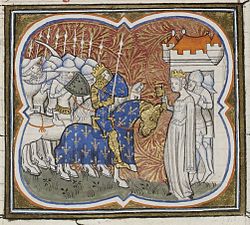
The rivalry between Bertha and Constance made the hatred between the families of Blois and Anjou worse. After a military victory by Odo II of Blois over Fulk III of Anjou in 1016, Queen Constance tried to strengthen her family's power. She and her relatives convinced the King to crown her eldest son, Hugh, as Junior King. This would ensure Constance would rule if Robert II died.
Against the advice of many nobles, Robert II agreed. Ten-year-old Hugh was crowned Junior King on 9 June 1017. This decision helped the Anjou family but could have put the King's life at risk. Robert II did not give his son any real power. Hugh was often humiliated by his mother. When he grew up, Hugh rebelled against his father but later made peace.
Expanding Royal Lands
Robert II worked to take back control of lands for the crown. His biggest success was gaining the Duchy of Burgundy.
Henry I, Duke of Burgundy died in 1002 without a direct male heir. He had named his stepson, Otto-William of Ivrea, as his heir. However, the Duchy of Burgundy was part of Robert II's family lands. Burgundy was also very important because it had rich cities like Dijon and Auxerre. Robert II claimed the duchy as his closest male relative.
A conflict over the city of Auxerre led Robert II to send his army into Burgundy in 1003. His troops, helped by soldiers from Normandy, failed to take Auxerre at first. In 1004, Robert II besieged Beaune. He gained control of Autun and Beaune, which forced Otto-William to seek a peaceful solution. By 1005, Robert II's forces took Avallon and Auxerre. Otto-William gave up his claim to the ducal title and most of his stepfather's lands.
The city of Dijon remained a problem. Its bishop, Brunon of Roucy, did not want Robert II to control it. In 1012, a fight broke out in Sens between Count Fromond II and Archbishop Léotheric. The Archbishop, who was close to the King, asked for Robert II's help. Robert II wanted to intervene because Sens was a major city and a key route to Burgundy. Taking Sens would also divide the lands of Odo II of Blois.
Renard II, Fromond II's son, allied with Odo II of Blois. Robert II attacked Sens and captured it on 22 April 1015. Renard II offered a compromise: he would rule as a vassal, and the land would return to the crown after his death. Renard II died 40 years later, and the County of Sens became part of the royal lands.
After Sens, Robert II went to Dijon to finish conquering Burgundy. The Abbot Odilo of Cluny convinced the King not to attack Dijon. When Bishop Brunon of Roucy died in 1016, Robert II's troops entered Dijon. Robert II installed a new bishop who gave Dijon and its county to the King. After 15 years of fighting and diplomacy, Robert II finally controlled the Duchy of Burgundy.
Robert II's second son, Henry, received the title of Duke of Burgundy. But since Henry was young, Robert II continued to govern it. When Henry's older brother, Hugh, died in 1027, Henry became the heir to the throne. The duchy then passed to Robert II's third son, Robert. His descendants would rule Burgundy for many years.
Other lands also came under royal control. When Bouchard I of Vendôme died in 1007, his County of Paris returned to the crown. In 1017, Robert II also gained the Counties of Melun and Dreux.
Religious Challenges and Persecutions
The Heretics of Orléans (1022)
Around the year 1000, new religious ideas, called "heresies," began to appear. Before this time, there wasn't much persecution for such beliefs. But in the 11th century, people accused of heresy were sometimes burned at the stake. The case of the heretics in Orléans in 1022 was very important during Robert II's reign.
Writers of the time described people who questioned the Church. For example, a peasant named Leutard of Vertus around 994 decided to leave his wife, destroy a crucifix, and tell villagers not to pay tithes. He was challenged by a bishop and eventually died. Similar situations happened with others who disagreed with Catholic teachings. They were often debated in public to make their ideas seem foolish.
Common ideas among these "heretics" included destroying religious images, saying the Church was useless, and rejecting sacraments like baptism and marriage. Some writers believed that Satan was behind these new ideas.
The most shocking part was that these ideas spread to Orléans, a royal city. Some church leaders in the cathedral, close to the court, supported these ideas. King Robert II was warned about this. On Christmas Day 1022, the accused heretics were arrested and questioned for many hours. They admitted to holding these beliefs, which included rejecting sacraments and questioning the Virgin Mary's virginity and the Trinity.
According to a story, Queen Constance even hit her confessor, Étienne, with her cane, injuring his eye, because he was involved in the heresy. Historians believe this event was downplayed in some writings to protect Robert II's reputation as a saintly king. This event was so significant that news of it reached as far as Catalonia. Some historians think this was also a way for the King to deal with political rivals.
Persecution of Jewish Communities
In 1007, the Caliph of Baghdad started persecuting Christians, destroying churches in places like Jerusalem. Robert II accused Jewish communities of helping the Muslims, even though Jews were also victims of Muslim persecution. This led to terrible actions against Jews in France, including theft, killings, and forced conversions.
A Jewish writer reported that a Jewish leader from Rouen traveled to Rome to ask Pope John XVIII for help. The Pope, who already had issues with Robert II's marriages, supported the Jewish community. His successor, Pope Sergius IV, also demanded that Robert II stop the anti-Jewish actions.
Later Years and Death
The last major event of Robert II's reign was the crowning of his second son, Henry, as Junior King. After his eldest son, Hugh, died in 1025, Queen Constance wanted her third son, Robert, to be the new co-ruler. Many in the royal court thought Henry was too weak. However, Robert II, supported by some powerful figures, insisted on Henry.
Henry was crowned Junior King on 14 May 1027. This event solidified the tradition of the reigning king choosing his heir. Important nobles from across the kingdom attended the ceremony. After the coronation, Queen Constance was reportedly furious and rode away.
In his later years (1027–1029), Robert II, who was over 55, faced political unrest. He had to settle conflicts in Normandy and Flanders. His sons, Henry and Robert, also rebelled against him, likely encouraged by their mother, Constance, in 1030. Robert II and Constance fled to Burgundy, where they joined forces with their son-in-law. Eventually, peace was restored within the royal family.
Robert II died on 20 July 1031, at his home in Melun, from a severe fever. Writers of the time recorded his death and burial. A few days before his death, on 29 June, a solar eclipse was seen. Many believed it was a bad sign.
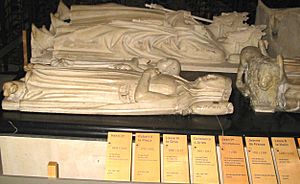
Robert II was highly respected by the monks of Saint-Denis Abbey. He was quickly moved from Melun to the Abbey, where his father was also buried. Robert II had given many gifts to the abbey. The monks wrote that after his death, rivers overflowed, a comet appeared, and a famine lasted for almost two years. Although his tomb was initially simple, his descendant, Louis IX of France (Saint Louis), later had new statues carved for all the royal family members in the 13th century.
Robert II and the Church
A "Monk King"
Kings, dukes, and counts in the year 1000 often gave rich gifts to monks to ensure their salvation. Robert II was a very religious Catholic, which is why he was called "the Pious." He loved music and was a composer, singer, and poet. He made his palace a quiet, religious place where he led morning and evening prayers in his royal robes.
Robert II's piety also meant he was very strict with those he considered heretics. He supported actions against Jewish communities in Orléans, who were accused of plotting to destroy the Church of the Holy Sepulchre in Jerusalem. He also brought back the old Roman custom of burning heretics at the stake.
Monasteries and Church Reform
Robert II's reign saw a strong revival of monasticism. Monks wanted to reform the Church and return to older traditions. They aimed to correct "the sins of the people." Monasteries became very popular. Kings and counts gave them land and valuable objects. Important abbots were asked to purify certain places.
Monasteries like Cluny and Fleury Abbey wanted to be free from the control of bishops. Abbots even went to Rome to ask the Pope for special privileges. In the southern parts of the kingdom, Cluny helped spread peace movements, like the Truce of God. However, in the northern areas, bishops often controlled powerful lands and didn't like the monks interfering. Some bishops criticized monks for living luxurious lives. Monks, in turn, accused bishops of being too rich and acting like warlords.
Robert II was asked to mediate disputes between bishops and monks. He often favored the monks. For example, he helped the Abbot of Fleury against a local lord who was causing trouble for the abbey. This showed that Robert II was more interested in monastic culture than in the power of bishops or the Pope, who were often linked to the Holy Roman Empire.
Robert II: The Ideal Prince
After Robert II's death, a monk from Fleury Abbey wrote his biography. This book aimed to show how saintly Robert II was. It presented him as a humble and kind prince who was charitable and forgiving. This image was different from typical royal descriptions. It showed the king following in the footsteps of Christ.
The Abbey of Fleury worked hard to make the Capetian monarchy seem legitimate. They created a new idea of what a king should be. According to Helgaud, Robert II was a "participant in the Kingship of God" since his coronation. He received a special anointing that gave him both earthly and spiritual power. Many church leaders saw Robert as God's representative on Earth. They called him "holy father" and "Father of the poor."
Another important scholar, Rodulfus Glaber, wrote about a meeting between Robert II and Henry II, Holy Roman Emperor in 1023. They discussed how to bring peace to all of Christendom. Some thinkers of the 11th century even saw Robert II as being as important as the Emperor.
The first Capetian kings, especially Robert II, were known for founding many religious institutions. Robert II's mother, Queen Adelaide, was very pious. She ordered the building of monasteries in Senlis and Argenteuil.
Robert II was a strong defender of saints. He believed they helped purify society and fight evil. He built or renovated many crypts for saints. He also gave pieces of holy relics to monks. Around 1015–1018, Robert II ordered a special reliquary for Saint Savinian at the request of his wife, Constance. This reliquary was made of gold and silver. Robert II gave many valuable items to churches, including robes, tablecloths, vases, and crosses.
Chosen by God
It's hard to fully understand how royalty was seen in Robert II's time. The king had authority over the princes of the Frankish kingdom, but they still had a lot of power. Some princes, like Odo II of Blois, respected the king but wanted to rule their lands as they pleased. However, the king was still seen as the "first among equals."
One day in 1027, "blood rain" fell in the Duchy of Aquitaine. This worried people, and William V of Aquitaine asked Robert II for an explanation. Robert II asked his scholars for advice. They explained that such signs often meant trouble for the Church and people, but that God's mercy would follow.
William V of Aquitaine could have asked his friend, Bishop Fulbert, directly. But he knew that Robert II was chosen by God. Therefore, he believed Robert II was the best person to understand God's will and the mysteries of the world. Even the most powerful men in the 11th century respected the king as God's chosen leader.
Robert II was the first king in his family to be credited with miraculous healing powers. This might have been a way to show the monarchy's importance, especially when its power was not always strong. It is said that Robert II could heal people with certain diseases, like lepers, during his travels in the South between 1018 and 1020. This power was seen as a gift from God, strengthened by the royal coronation. Robert II also went on pilgrimages to visit holy relics.
Images for kids
See also
 In Spanish: Roberto II de Francia para niños
In Spanish: Roberto II de Francia para niños


